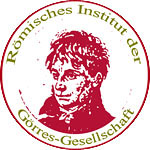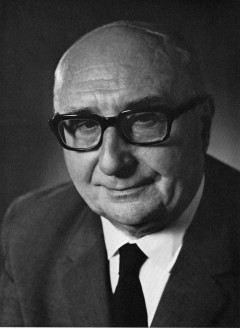The first bography of the patrologist Johannes Quasten
A thriller in parts: the University of Münster, the University of Bonn, the Campo Santo Teutonico and what else belongs to it
The priest Johannes Quasten (1900-1987) of the diocess Münster had to go into exile in America during the National Socialist era and was lucky to receive a professorship in patrology at the Catholic University of America in Washington. (The "half-arian" Hubert Jedin had also applied for this professorship, while Erik Peterson had turned it down). Quasten then became famous for publishing the text edition "Ancient Christian Writers" and the so-called Quasten Patrology, a three-volume handbook on the Church Fathers, which contributed to the reputation of the young American university.
Norbert M. Borengässer (Bonn), who worked for a long time with Prof. Ernst Dassmann at the Chair of Ancient Church History, has published a 205-page biography of Quasten: "Johannes Quasten (1900-1987) - von einem der ausog, seiner Berufung zu folgen" (self-published 2022). In it, he has presumably evaluated all relevant archival sources.
Quasten, who came from the Lower Rhine, belonged to the scientific network of the Dölger School in Münster-Bonn. From 1927-1929 he was a young priest at Campo Santo Teutonico and studied at the Pontifical Institute for Christian Archaeology, where he tried in vain to obtain a teaching post in 1938. Instead, he then went to the USA.
Until now, only the skeleton of Quasten's life was known (Personenlexikon zur Christlichen Archäologie, 2012, p. 1049f). Borengässer now describes for the first time, in an easily readable and at times exciting manner, the entire life of the priest and scholar, who had to go tortuous ways to obtain a living position as a professor, emigrated to the USA in 1938, took annual holidays in the Black Forest from 1946, and settled in Freiburg i.Br. for his retirement in 1977/78.
Borengässer traces Quasten's academic career in detail, but also places him in his personal network. He compiles a selection of his colleagues and friends (p. 80ff): among others Berthold Altaner, Odo Casel, Franz Josef Dölger, Albert Ehrhard, Hubert Jedin, Josef Andreas Jungmann, Theodor Klauser, Cunibert Mohlberg, Erik Peterson, the Rahner brothers and Karl Theodor Schäfer. In addition, Borengässer counts 38 of Quasten's students at the Catholic University and collects detailed prosopographical information on them (pp. 59ff).
Of course, the chapters dealing with crises and intrigues of which Quasten was a victim are exciting. Here Borengässer brings many backgrounds to light. The first crisis (p. 31ff) concerns his failure at the University of Münster in 1937/38, as the National Socialists had infiltrated the Catholic student burse under his leadership. In the end, Quasten's teaching licence was revoked by the Nazis.
It is precisely this crisis that Klauser then uses against him 25 years later, leading to the second crisis case (pp. 143ff) at Bonn University. "Ultimately, it is embedded in the failed attempt here by German universities or faculties to try to right wrongs suffered in the so-called Third Reich" (p. 143). The fact that Quasten did not even make it onto the list for Klauser's successor to the chair of Ancient Church History in 1962, despite the injustice suffered at the hands of the Nazis, was - roughly speaking - due to Klauser's own intrigue, which could hardly be surpassed in hypocrisy (cf. p. 147). An object lesson in the bashing and stabbing of "dear colleagues" at some universities (Borengässer's Moral der Geschicht' is very correct: p. 185).
The author is to be congratulated on this splendid quotation from Schäfer in a letter to the Dean of the Catholic Faculty in Bonn (for this alone it is worth reading the book). Schäfer honourably stands up for Quasten against Klauser, saying (about the latter): "one of the strangest experiences I have had to make in three decades of academic teaching is how strikingly often the memory of historians in particular, who believe they can teach us about events many centuries ago, fails when it concerns events of the recent past in which they were involved" (p. 149) - a typical case of "historical farsightedness".
This sentence of the true hero of this book, the Cologne priest and Bonn professor Karl Theodor Schäfer (1900-1974), Quasten's contemporary, is also beautiful. Borengässer thankfully allows Schäfer to speak at length when he writes at the end of these sad events in 1962: "The names Klauser and Quasten are inseparably linked with the memory of three of the most beautiful years of my life, which [we] spent in the Campo Santo Teutonico in Rome from 1925 to 1928. Since that time I have been on friendly terms with both of them, but far more with Mr Klauser than with Mr Quasten" (p. 183).
- Details
- Written by: Stefan Heid
- Category: Recommended reading
 Römisches Institut der Görres-Gesellschaft
Römisches Institut der Görres-Gesellschaft







